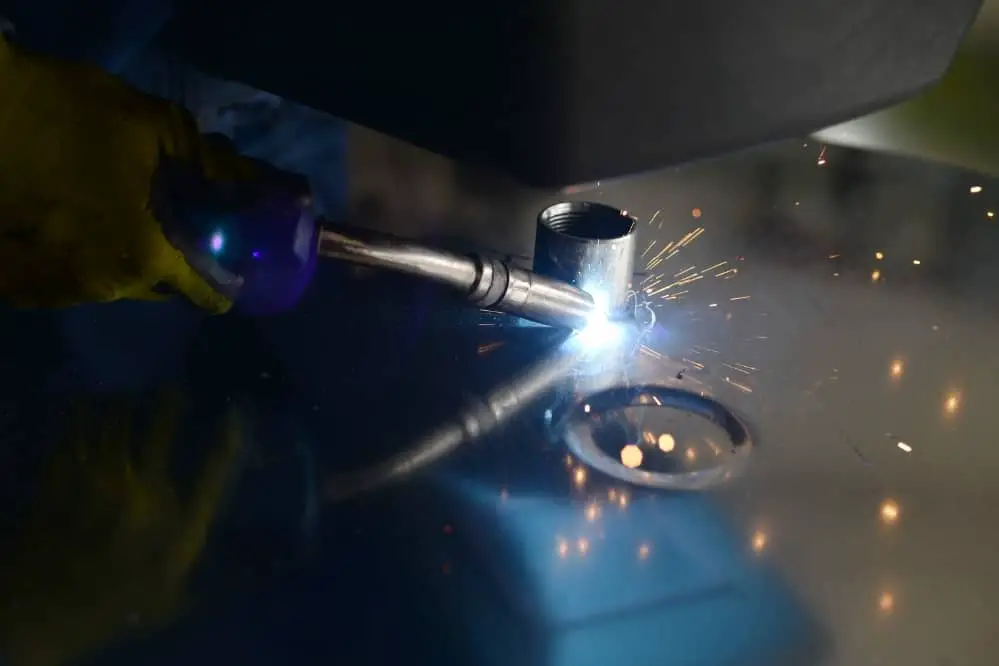As most of us already know, MIG (“metal inert gas”) welding – which is also known as gas metal arc welding (GMAW) and wire welding – refers to an arc welding process where a continuous solid wire electrode is run through a welding gun and into the weld pool to join the two base metals together. The welding gun also emits a shielding gas, which is intended to protect the weld pool from contamination.
The principle behind MIG welding is that the shielding gas protects the weld pool. So, technically, there is no way to do MIG welding without gas. What most people mean by this question, however, is – can you use an MIG welder without attaching a cylinder of gas? The answer to that is yes, you can.
Self-Shielding/Innershield MIG Wires
In MIG welding, a continuous wire is run through the welding gun and into the weld pool. A self-shielding – also known as innershield or flux-core arc welding (FCAW) – wire is a metallic tube that’s filled with flux core. When it is heated in the weld gun, the flux core melts. This produces a gas that shields the weld pool area in the same way as gas from the canister.
The melted flux also creates a protective slag, which integrates alloys into the weld metal to produce certain mechanical properties. So, using these self-shielding wires protect against oxidation and contamination the same way that gas from a canister does. They generate an intensely hot arc, which is what melts the flux core, and this arc is suitable for use on steel that is less than 1.2 millimeters thick.
The first flux core wire was developed by Arthur Bernard in 1954; Bernard named it Dualshield. A self-shielded flux core wire was invented in 1959 and it was called Innershield. It was trademarked by the Lincoln automobile company.
Self-shielded wires were also used around that time for MIG welding without gas canisters on large Midwestern farms. A handheld MIG welder that operated off a tractor battery could make immediate repairs to gates and fences.
In the 1980s, retailers could not sell MIG welders to individuals because disposable gas cylinders were not yet on the market. Self-shielded wires became available in the UK and that sparked the home/hobby/DIY welding market.
Pros of gasless self-shielding MIG wires include:
- Easier to use; no need to monitor welding parameters
- More convenient and portable
- Suitable for rusted or painted surfaces
- Great for welding outdoors since gas won’t blow away in the wind
- Offers better arc control
- More efficient
Cons of gasless self-shielding MIG wires include:
- Limited positioning
- Toxic fumes
Considerations when switching to gasless MIG welding include:
Maintaining compliance with welding codes: These codes are established by the D1 committee of the American Welding Society. Welders may need additional certifications to perform gasless MIG welding procedures.
Maintaining voltage and heat: Self-shielding wire needs to have a constant voltage power source and maintain the optimal voltage throughout the procedure. You will see irregularities or other mistakes if the equipment cannot maintain a steady voltage. The same applies to maintaining the proper heat input.
Selecting the correct wire: You need to be sure to use the proper self-shielding flux core wire. Seismic requirements are different for MIG. The wire you use has to have the appropriate strength, chemical properties, and mechanical properties for the job at hand.
Maintaining speed and angle: For gasless MIG welding in the vertical position, you need to keep the welding gun at a 5- to 15-degree angle. In the horizontal position, the gun needs to be at a drag angle of 15 to 40 degrees. In both cases, the speed needs to be consistent or the piece may puddle and produce slag.
Maintaining the right penetration: You should monitor how much weld metal is depositing to the joint, and that there is adequate space between the weld bed and the weld joint to accommodate the weld metal. If necessary, reduce the voltage and slow down the wire feed to reduce penetration.
Cleaning the welding material between passes: Cleaning the surface of the base metal thoroughly before each new pass removes contaminants that can cause fusion issues. Remove slag with a wire brush or chipping hammer.
Preventing porosity: You can prevent porosity by using filler metals with deoxidizers, and ensuring that the wire stick-out is at the proper distance from the tip.
Preventing wormtracking: Wormtracking happens when marks are left on the weld bead surface by the fumes released from the wire. Maintain the recommended voltage, and turn it down slightly if you notice wormtracking.
MIG Welders
Some welders are designed for MIG welding with a gas canister, some are designed for MIG welding without gas, and some can be used for both. If you have a welder that can do both, you will need to change the polarity when you are switching from welding with a gas canister to welding with self-shielded wire.
If you are welding with self-shielded wire and using the wrong polarity, you are likely to see lots of spatter and an imprecise weld. For MIG welding without gas, your settings should be on direct current electron negative (DCEN). The negative terminal should be hooked up to the MIG gun and the positive terminal to the ground. Electrons flow from negative to positive, so they travel from the machine to the weld gun, through the workpiece and the ground cable, and back to the machine.
It is also possible to convert a MIG welder that was designed for use with shielding gas to one that can be used with self-shielding flux core wire instead. Besides switching the polarity, you will have to replace the rollers inside the feeder with purpose-built rollers with a knurled groove.

